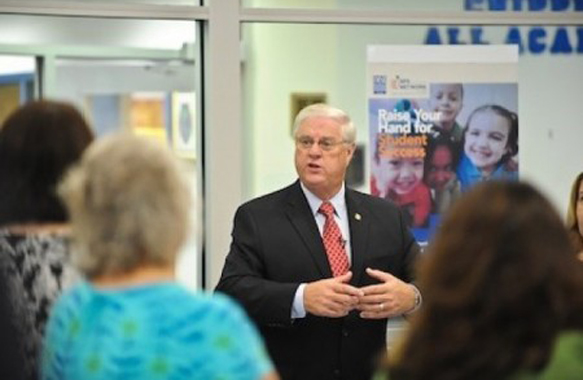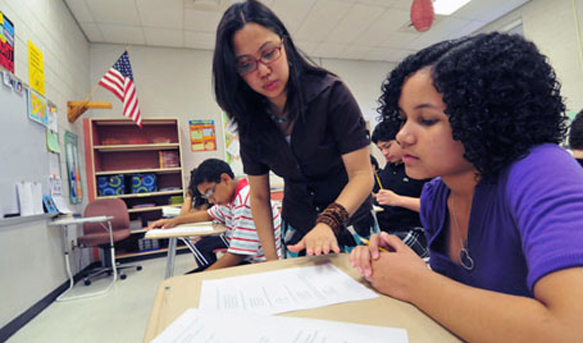In response to many calls from students, parents, and teachers, opinions have changed. Courses too. Now, the President of the National Education Association says it is time for a correction. In respect to the Common Core State Standards or the assessments used to fulfill this agenda, he exclaims, “This is not ‘accountability’—it’s malpractice.” To read his full statement…
NEA President: We Need a Course Correction on Common Core
During my 23 years as a high school math teacher, I learned some important lessons. One of the most important was that effective teaching and learning required me at times to be the teacher and at other times, the student. I listened closely to my students because they were the ones who told me what was working and what wasn’t. I don’t believe I am any different than any other NEA member—we all want the best for every student in our classrooms and schools.
So when 45 states adopted the Common Core State Standards (CCSS), we as educators saw the wonderful potential of these standards to correct many of the inequities in our education system that currently exist. Educators embraced the promise of providing equal access to high standards for all students, regardless of their zip code or family background.
We believed the standards would helpstudents develop the critical thinking and problem-solving skills they need to succeed in the fast-changing world. NEA members overwhelmingly supported the goals of the standards because we knew they could provide a better path forward for each and every student. The promise of these high standards for all students is extraordinary. And we owe it to our students to fulfill that promise.
As educators, we also had high hopes that our policymakers would make an equal commitment to implement the standards correctly by providing students, educators, and schools with the time, supports, and resources that are absolutely crucial in order to make changes of this magnitude to our education system.
So over the last few months I have done what my students and fellow educators have taught me: I have been listening closely. I have joined our state leaders in member listening sessions around the country, observed dozens of member focus groups, and invited hundreds of thousands of NEA members to share their views about how CCSS implementation is going.
I am sure it won’t come as a surprise to hear that in far too many states, implementation has been completely botched. Seven of ten teachers believe that implementation of the standards is going poorly in their schools. Worse yet, teachers report that there has been little to no attempt to allow educators to share what’s needed to get CCSS implementation right. In fact, two thirds of all teachers report that they have not even been asked how to implement these new standards in their classrooms.
Imagine that: The very people expected to deliver universal access to high quality standards with high quality instruction have not had the opportunity to share their expertise and advice about how to make CCSS implementation work for all students, educators, and parents.
Consequently, NEA members have a right to feel frustrated, upset, and angry about the poor commitment to implementing the standards correctly.
So, where do we go from here?
NEA has been called upon to oppose the standards. It would be simpler just to listen to the detractors from the left and the right who oppose the standards. But scuttling these standards will simply return us to the failed days of No Child Left Behind (NCLB), where rote memorization and bubble tests drove teaching and learning. NEA members don’t want to go backward; we know that won’t help students. Instead, we want states to make a strong course correction and move forward.
So the first step is for policymakers to treat teachers as professionals and listen to what we know is needed. Give us the resources and time—time to learn the standards, collaborate with each other, develop curriculum that is aligned to the standards, and time to field-test the standards in classrooms to determine what works and what needs adjustment. We also need the financial resources for updated textbooks and fully aligned teaching and learning materials.
Second, work with educators—not around us—to determine how to properly use assessments in classrooms across America. It’s beyond me how anyone would ask teachers to administer tests that have no relation whatsoever to what they have been asked to teach. In too many states, that’s exactly what’s happening.
Old tests are being given, but new and different standards are being taught. How on earth does that give any teacher, student, or parent information that is relevant to what they need to know or how they can improve? Why would we waste valuable learning time for students? And, then, to make matters worse, many states are proceeding to use these invalid test results as the basis for accountability decisions.
This is not ‘accountability’—it’s malpractice.
In states that have made a commitment to involving teachers up front and providing teachers with the time, training, and resources they need to make the standards work, educator support for the standards is strong.
So if better teaching and learning is our goal, then policymakers need to implement educators’ common sense recommendations to get implementation on track:
- Governors and chief state school officers should set up a process to work with NEA and our state education associations to review the appropriateness of the standards and recommend any improvements that might be needed.
- Common Core implementation plans at the state and local levels must be collaboratively developed, adequately resourced, and overseen by community advisory committees that include the voices of students, parents, and educators.
- States and local school districts must place teachers at the center of efforts to develop aligned curriculum, assessments, and professional development that are relevant to their students and local communities.
- States must eliminate outdated NCLB-mandated tests that are not aligned with the new standards and not based on what is being taught to students in the classroom.
- States must actively engage educators in the field-testing of the new assessments and the process for improving them.
- In any state that is field-testing and validating new assessments, there must be a moratorium on using the results of the new assessments for accountability purposes until at least the 2015-2016 school year. In the meantime, states still have other ways to measure student learning during this transition period—other assessments, report cards, and student portfolios.
- Stakeholders must develop complete assessment and accountability systems. It takes more than one piece of evidence to paint a picture of what students are learning. Testing should be one way to inform effective teaching and learning—not a way to drive it.
I know that NEA members are committed to seeing the promise of the standards fulfilled. But we can’t do it alone. Elected officials, school administrators, and other stakeholders are part of the accountability system, too, and that means stepping up and accepting more responsibility to get CCSS implementation right. There’s too much at stake for our children and our country to risk getting this wrong.
Visit nea.org/commoncore for more information and resources.
See Related Teachers Union Head Calls For Core ‘Course Correction’













Leave A Comment